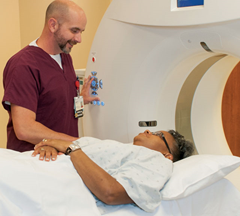- Cardiology And Vascular Health
- Health Topics
- Heart Health
- Understanding Heart Disease
- Vascular Health
Aortic Dissection: What To Know

Answer a few questions and we'll provide you with a list of primary care providers that best fit your needs.
The aorta is your body’s largest blood vessel — the critical main supply line of life-sustaining blood from your heart.
All is good when the aorta’s three-layered wall retains its natural resiliency, providing give-and-take like a new elastic band, with each pump of your heart.
But several risk factors — a few of them hereditary, others lifestyle — may reduce the aorta’s elasticity. This can lead to a potentially life-threatening condition — aortic dissection— in which a tear develops in the inner layer.
Much less common than other cardiovascular diseases, aortic dissection makes headlines from time to time. For instance, actor Alan Thicke died suddenly after his aorta ruptured due to aortic dissection in December 2016. Actors John Ritter and Lucille Ball died similarly.
Most Often a Sudden Onset
In most cases, symptoms come on suddenly. They include severe chest pain.
John M. Miller, MD, describes it: “A sudden onset, ripping, tearing chest pain that radiates to the back and shoulders. ‘Ripping and tearing pain,’ those are words people actually use to describe it.”
These symptoms indicate that the aorta has ruptured — or is about to — and that life-saving surgery is needed immediately. A vascular surgeon removes and replaces the torn section of aorta with a synthetic graft. Sometimes a heart valve is damaged, also requiring replacement.
When your aorta ruptures, you have a 50 percent chance of survival.
In fewer cases, the condition is discovered before it reaches this severity. Dr. Miller said that in four or five cases in his 17-year medical career he has diagnosed aortic dissection when examining a patient for another condition.
And in a few cases, patients have come to him complaining of symptoms, like a painful, cold leg or abdominal pain. Symptoms like this indicate compromised blood flow, which can be caused by a tear in the aorta.
Imaging technologies, such as a CT scan, are used to screen for the condition.
Types Of Aortic Dissections
When a tear develops in the inner layer of the aorta, blood pushes through and separates, or dissects, the inner and middle layers. This can impede blood flow to organs. And it may eventually rupture through the outer layer, which can be fatal.
There are two types of aortic dissections:
- Type A. These occur suddenly in the upper or ascending aorta and are life-threatening, requiring immediate surgery.
- Type B. These occur in the descending aorta and usually can be treated with medicine to control blood pressure. However, Dr. Miller said, the aortic dissection can enlarge over time and eventually require surgery.
Symptoms Of Aortic Dissection
The most commonly reported symptom of an acute Type A aortic dissection is the severe ripping and tearing pain that Dr. Miller described above. The pain may move to the shoulder blades, back, neck, arms, jaw, abdomen, or hips.
Other symptoms include:
- Anxiety and feeling of doom
- Fainting, dizziness, or confusion
- Clammy skin, sweating
- Pale skin
- Nausea and vomiting
- Rapid, weak pulse
- Trouble breathing, shortness of breath when lying flat
- Weakness or paralysis on one side of the body
- A weaker pulse in one arm than in the other
- Difficulty speaking and swallowing
Risk Factors Of Aortic Dissection
Men are at greater risk of aortic dissection than women. Though, in relatively rare instances, otherwise healthy women have suffered aortic dissection in the third trimester of pregnancy due to hormonal changes.
Dr. Miller said the greatest factors contributing to aortic dissection are family history and hereditary connective tissue disorders such as Marfan syndrome. These disorders increase the size of the aorta and decrease the elasticity of the aortic wall, making it brittle and prone to tears and dissection.
Other risk factors include:
- Uncontrolled high blood pressure, which works against the walls of the aorta, particularly when they’re weakened
- Hardening of the arteries
- “Smoking is huge,” adds Dr. Miller. “A double-digit number of chemicals in cigarette smoke break down the components of the wall of the aorta.”
- Bicuspid aortic valve, a defect in which the valve has only two flaps, rather than the normal three
- Inflammation of the aorta
- Narrowing of the aorta at birth
- Use of drugs, such as cocaine, which dramatically spike blood pressure
- High-intensity weightlifting, and other strenuous resistance training, that cause an intense, temporary rise in blood pressure
Occasionally, dissection is caused by trauma, such as the result of sudden deceleration in a car accident. The dissection may not be recognized at the time. But the initial tear may grow and cause symptoms later.
‘Ripping and tearing pain,’ those are words people actually use to describe it.”
Prevention Of Aortic Dissection
While some causes of aortic dissection are hereditary, here’s how you can reduce your risk:
- Test your blood pressure regularly
- Follow your doctor’s orders for managing your blood pressure
- Don’t use recreational drugs
- Don’t smoke. But if you do, ask your doctor for recommendations of a smoking cessation program.
Answer a few questions and we'll provide you with a list of primary care providers that best fit your needs.
Source: Society for Vascular Surgery; MedlinePlus; Healthline; John M. Miller, MD, Greater Dayton Cardiothoracic and Vascular Surgeons





